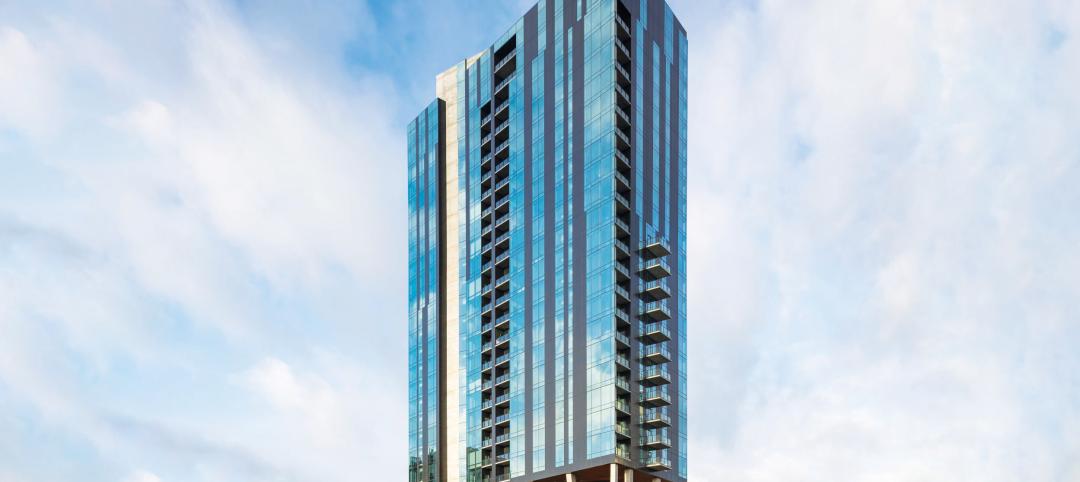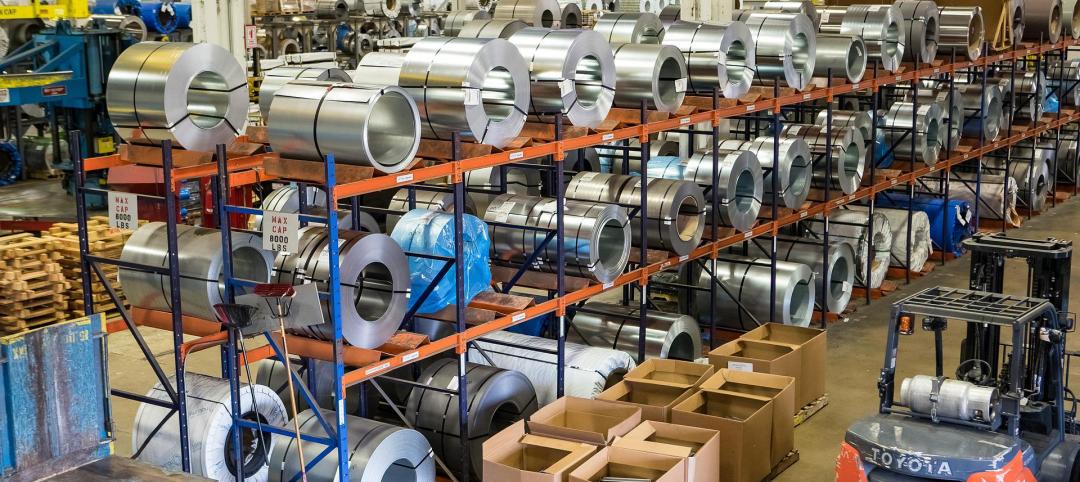 |
|||||||||||||||||||||||||
| The $9.2 billion CityCenter complex in Las Vegas is the nation’s largest privately funded development. Key: A. Mandarin Oriental (Kohn Pedersen Fox Associates); B. Veer (Murphy/Jahn Architects); C. Crystals (Studio Daniel Libeskind); D. The Harmon (Foster + Partners); E. People mover (Gensler); F. Vdara (Rafael Viñoly Architects); G. Aria (Pelli Clarke Pelli); H. Convention Center (Pelli Clarke Pelli); I. Cirque du Soleil theater (Pelli Clarke Pelli). | |||||||||||||||||||||||||
It's early June, in Las Vegas, which means it's very hot, and I am coming to the end of a hardhat tour of the $9.2 billion CityCenter development, a tour that began in the air-conditioned comfort of the project's immense sales center just off the famed Las Vegas Strip and ended on a rooftop overlooking the largest privately funded development in the U.S. and one of the largest construction projects in the world. Only from such a height can you take in the enormity of this 18.6 million-sf mixed-use project. The statistics are staggering: a massive joint venture
It goes without saying that looking at the scale model of the project in the sales office just doesn't do justice to CityCenter. Thus I find myself atop the Bellagio Hotel parking garage, chatting with several architects from the Las Vegas office of San Francisco-based Gensler, the project's master architect. The newly constructed garage borders CityCenter and offers a bird's-eye view into the heart of the project, and it is from this vantage point that I begin to appreciate just how different CityCenter is from anything ever built in Las Vegas.
Apparently my response to the project is not unique. “People don't really understand it or feel it until they walk through it,” says Sven Van Assche, VP of MGM Design Group. “It's experiential, the progression of taking yourself through the project, going from neighborhood to neighborhood, from experience to experience,” he says. “We are doing something so different from what we've done before, something outside our own box.” Van Assche acknowledges how a project of this scale could easily become intimidating and overwhelming, emotions at odds with MGM Mirage's core business of providing hospitality. He worked with New York-based Ehrenkrantz Eckstut and Kuhn Architects to create a master plan that broke down the project's scale into three neighborhoods with the unpoetic titles Blocks A, B, and C. The goal, according to Van Assche: “to make being in CityCenter a more inviting, comfortable, and welcoming experience for the customer.” The concept of neighborhood reinforces CityCenter's urban aspirations. Van Assche, sounding very much like a disciple of Jane Jacobs, says that a walk around a city like New York produces multiple experiences that come from encountering diverse building types—stores, restaurants, hotels, housing, entertainment venues—with surprises around every corner. “What makes great cities so much fun is their diversity and energy,” says Van Assche. “We're trying to create that energy.” Creating a real-city vibe through a diverse product mix led Van Assche to seek out world-class architects who hadn't previously worked in Las Vegas, each of whom could all add something new and exciting to the mix. Van Assche says he sought designers with global reputations and the ability to work as a cohesive team. “It was about finding the most creative architects who could fit the vision we were trying to achieve,” he says. “They've been successful in doing enormously creative work around the world, and they've done so in an architectural vernacular we were interested in ourselves,” says Van Assche. Before anyone signed on, however, Van Assche made sure they checked their egos at the airport. “They had to be interested in being part of a project where it wasn't all about them,” he says. “They needed to understand how intimately we were going to integrate these buildings with one another, and that they would have to collaborate with people who are normally their competitors.” The bottom line: “The synergy had to be positive.” A two-month-long design review helped sort out the assignments: Pelli Clark Pelli was awarded the Aria hotel, casino, convention center, and Cirque du Soleil theatre; Rafael Viñoly Architects, the Vdara condo hotel; Kohn Pedersen Fox Associates, the Mandarin Oriental; Murphy/Jahn, the Veer condominium towers; Foster + Partners, The Harmon hotel and residential tower; and Studio Daniel Libeskind, Crystals retail complex. Each firm was granted significant autonomy over their respective projects as long as they worked within the contemporary aesthetic that MGM Mirage wanted. “The architects all created buildings that are very unique unto themselves, but they did it all using the same ingredients,” says Van Assche. |
Related Stories
Mass Timber | Jan 27, 2023
How to set up your next mass timber construction project for success
XL Construction co-founder Dave Beck shares important preconstruction steps for designing and building mass timber buildings.
Products and Materials | Jan 18, 2023
6 innovative products for multifamily developments
Here are six innovative products for various multifamily developments, including a condominium-wide smart electrical system, heavy-duty aluminum doors, and prefabricated panels.
Green | Dec 9, 2022
Reaching carbon neutrality in building portfolios ranks high for organizations
Reaching carbon neutrality with their building portfolios ranks high in importance among sustainability goals for organizations responding to a Honeywell/Reuters survey of senior executives at 187 large, multinational corporations. Nearly nine in 10 respondents (87%) say that achieving carbon neutrality in their building portfolio is either extremely (58%) or somewhat (29%) important in relation to their overall ESG goals. Only 4% of respondents called it unimportant.
Energy Efficiency | Dec 6, 2022
Washington state’s Building Code Council mandates heat pumps in all new residential construction
The Washington State Building Code Council has voted to require heat pumps for all new residential construction starting in July 2023. The new mandate has drawn criticism over concerns that it will add costs to housing construction, especially given current supply chain challenges for heat pumps.
Geothermal Technology | Dec 6, 2022
Google spinoff uses pay-as-you-go business model to spur growth in geothermal systems
Dandelion Energy is turning to a pay-as-you-go plan similar to rooftop solar panel leasing to help property owners afford geothermal heat pump systems.
75 Top Building Products | Nov 30, 2022
75 top building products for 2022
Each year, the Building Design+Construction editorial team evaluates the vast universe of new and updated products, materials, and systems for the U.S. building design and construction market. The best-of-the-best products make up our annual 75 Top Products report.
Building Materials | Nov 2, 2022
Design for Freedom: Ending slavery and child labor in the global building materials sector
Sharon Prince, Founder and CEO of Grace Farms and Design for Freedom, discusses DFF's report on slavery and enforced child labor in building products and materials.
Building Materials | Aug 3, 2022
Shawmut CEO Les Hiscoe on coping with a shaky supply chain in construction
BD+C's John Caulfield interviews Les Hiscoe, CEO of Shawmut Design and Construction, about how his firm keeps projects on schedule and budget in the face of shortages, delays, and price volatility.
Building Materials | Jun 20, 2022
Early-stage procurement: The next evolution of the construction supply chain
Austin Commercial’s Jason Earnhardt explains why supply chain issues for the construction industry are not going to go away and how developers and owners can get ahead of project roadblocks.
Wood | Jul 16, 2021
The future of mass timber construction, with Swinerton's Timberlab
In this exclusive for HorizonTV, BD+C's John Caulfield sat down with three Timberlab leaders to discuss the launch of the firm and what factors will lead to greater mass timber demand.



















